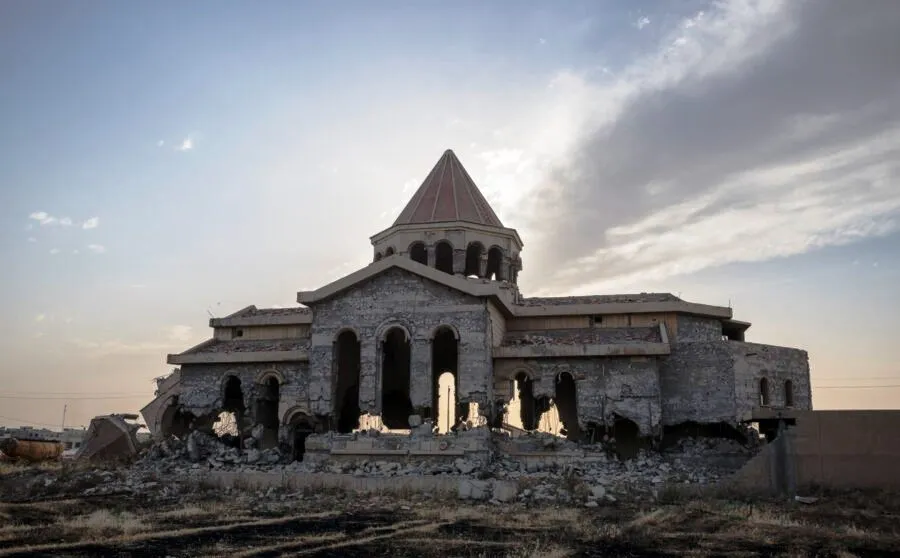هل هناك إبادة جماعية أرمنية جديدة تلوح في الأفق؟
ريمون ابراهيم/29/شباط 2024
Is a New Armenian Genocide on the Horizon?
Raymond Ibrahim/February 28/2024
Turkic genocidal bloodlust against its ancient victim, Armenia, is on the verge of flaring out again, though the world fails to see. On Feb. 13, 2024, Azerbaijan opened fire on and killed four Armenian soldiers in bordering Syunik, Armenia. Two days later, on Feb. 15, Armenian Prime Minister Nikol Pashinyan warned that Azerbaijan is planning a “full-scale war” on Armenia. Such a war would certainly be in keeping with Azerbaijan’s behavior in recent months and years.
Modern day hostilities between Armenia, an ancient nation and the first to adopt Christianity, and Azerbaijan, a Muslim nation that was created in 1918, began in September 2020, when Azerbaijan launched a war to claim Artsakh, more commonly known as Nagorno-Karabakh. Although it had been Armenian for over two thousand years, and 90% of its inhabitants were Armenian, after the dissolution of the USSR, the “border makers” had granted it to Azerbaijan, hence the constant warring over this region. (See “15 Artsakh War Myths Perpetuated By Mainstream Media.”)
Once the September 2020 war began, Turkey quickly joined its Azerbaijani co-religionists against Armenia, though the dispute clearly did not concern it. It dispatched sharia-enforcing “jihadist groups” from Syria and Libya—including the pro-Muslim Brotherhood Hamza Division, which once kept naked women chained and imprisoned—to terrorize and slaughter the Armenians.
One of these captured mercenaries later confessed that he was “promised a monthly $2,000 payment for fighting against ‘kafirs’ in Artsakh, and an extra 100 dollars for each beheaded kafir.” (Kafir, often translated as “infidel,” is Arabic for any non-Muslim who fails to submit to Islam, which makes them de facto enemies.)
Among other ISIS-like crimes committed by the Islamic coalition of mercenaries, Turks, and Azerbaijanis that waged war on Armenia in late 2020, they “tortured beyond recognition” an intellectually disabled Armenian woman by sadistically hacking off her ears, hands, and feet, before finally executing her.
Similarly, video footage showed camouflaged soldiers overpowering and forcing down an elderly Armenian man, who cries and implores them for mercy, as they casually try to carve at his throat with a knife. Azerbaijani soldiers also raped an Armenian female soldier and mother-of-three, before hacking off all four of her limbs, gouging her eyes, and mockingly sticking one of her severed fingers inside her private parts.
Such unbridled sadism is par for the course, said Arman Tatoyan, an Armenian human rights activist:
The President of Azerbaijan and the country’s authorities have been implementing a policy of hatred, enmity, ethnic cleansing and genocide against Armenia, citizens of Armenia and the Armenian people for years. The Turkish authorities have done the same or have openly encouraged the same policy.
At any rate, the war ended in November 2020, with Azerbaijan claiming a significant portion of Artsakh.
Almost immediately, and as if to underscore the religious aspect of the conflict, Muslim Azerbaijan began to systematically erase Artsakh’s ancient Christian heritage—destroying churches, crosses, Christian cemeteries, and other cultural landmarks. In one instance, an Azerbaijani stood atop an Armenian church, after its cross had been broken off, triumphantly crying “Allahu Akbar!”
Then, on December 12, 2022, Azerbaijan sealed off the Lachin Corridor—the only route between Artsakh and the outside world, prompting a months’ long humanitarian crisis. On August 7, 2023, Luis Moreno Ocampo, the former Chief Prosecutor of the International Criminal Court, summarized the then situation well:
There is an ongoing Genocide against 120,000 Armenians living in Nagorno-Karabakh, also known as Artsakh.
The blockade of the Lachin Corridor by the Azerbaijani security forces impeding access to any food, medical supplies, and other essentials should be considered a Genocide under Article II, (c) of the Genocide Convention: ‘Deliberately inflicting on the group conditions of life calculated to bring about its physical destruction.’
There are no crematories, and there are no machete attacks. Starvation is the invisible Genocide weapon. Without immediate dramatic change, this group of Armenians will be destroyed in a few weeks.
This, of course, was not the first time that Turks starved Armenians to death (as a picture of a Turkish administrator taunting emaciated Armenian children with a piece of bread in 1915 makes clear).
Similarly, after going on a fact-finding mission to Armenia, former U.S. Ambassador-at-Large for International Religious Freedom, Sam Brownback referred to the blockade as the latest attempt at “religious cleansing” of Christian Armenia:
Azerbaijan, with Turkey’s backing, is really slowly strangling Nagorno-Karabakh. They’re working to make it unlivable so that the region’s Armenian-Christian population is forced to leave, that’s what’s happening on the ground. In his testimony, Brownback said that this latest genocide was being “perpetrated with U.S.-supplied weaponry and backed by Turkey, a member of NATO.” If the U.S. does not act, “we will see again another ancient Christian population forced out of its homeland.”
And so we did: on Sept. 19, 2023, Azerbaijan launched another large scale military offensive against Artsakh, prompting an exodus of its beleaguered and emaciated Armenians. Then, on Jan.1, 2024, the Armenian Republic of Artsakh was formally dissolved. Despite Azerbaijan’s total victory—which some international observers thought might put an end to hostilities between the two nations—six weeks later, an ever-expanding Azerbaijan opened fire on Armenia proper, killing the aforementioned four soldiers last week.
“Our analysis shows that Azerbaijan wants to launch military action in some parts of the border with the prospect of turning military escalation into a full-scale war against Armenia,” said Armenian Prime Minister Nikol Pashinyan at a government meeting last week. “This intention can be read in all statements and actions of Azerbaijan.”
The Armenian government is rightfully concerned that Azerbaijan, emboldened by its unimpeded successes, is preparing to invade more Armenian territory. As should be clear by now, no amount of appeasement short of total capitulation will seemingly ever satisfy Armenia’s powerful Muslim neighbors, namely Azerbaijan and its “big brother,” Turkey.
Appropriating Artsakh appears to be only the first step of a larger project. As Azerbaijan’s president, Ilham Aliyev, once proclaimed, “Yerevan [the capital of Armenia] is our historical land and we Azerbaijanis must return to these historical lands.” He has also referred to other ancient Armenian territories, including the Zangezur and Lake Sevan regions, as “our historic lands.” Taking over those territories “is our political and strategic goal,” Aliyev maintains, “and we need to work step-by-step to get closer to it.”
Back in the real world, Armenians founded Yereyan, their current capital, in 782 BC—exactly 2,700 years before Azerbaijan came into being in 1918. And yet, here is the president of Azerbaijan waging war because “Yerevan is our historical land and we Azerbaijanis must return to these historical lands.” Armenia was also significantly larger, encompassing even modern day Azerbaijan within its borders, over two thousand years ago. Then the Turkic peoples came riding in from the east, slaughtering, enslaving, terrorizing and stealing the lands of Armenians and other Christians of the region in the name of jihad (as discussed here).
As Longtime Armenian-activist, Lucine Kasbarian, author of Armenia: A Rugged Land, an Enduring People, put it, Dictator Ilham Aliyev’s belligerent stance towards Armenia is in keeping with Azerbaijan’s long “war of aggression” towards Armenia and its people. Aliyev’s agenda is to conquer what is left of sovereign Armenia all while claiming to be the victim rather than the victimizer. The Aliyev regime even goes so far as to refer to Armenia as “Western Azerbaijan,” even though Armenia has existed on ancient maps for thousands of years while Azerbaijan was first created in 1918.
In short, all modern day pretexts and “territorial disputes” aside, true and permanent peace between Armenia and its Turkic neighbors will only be achieved when the Christian nation has either been conquered or ceded itself into nonexistence. Nor would it be the first to do so. It is worth recalling that the heart of what is today called “the Muslim world”—the Middle East and North Africa (MENA)—was thoroughly Christian before the sword of Islam invaded. Bit by bit, century after century following the initial Muslim conquests and occupations, it lost its Christian identity, its peoples lost in the morass of Islam, so that few today even remember that Egypt, Iraq, Syria, etc., were among the first and oldest Christian nations.
Armenia—the first nation in the world to adopt Christianity—is a holdout, a thorn in Islam’s side, and, as such, will never know lasting peace from the Muslims surrounding it.
https://www.raymondibrahim.com/2024/02/28/is-a-new-armenian-genocide-on-the-horizon/
هل هناك إبادة جماعية أرمنية جديدة تلوح في الأفق؟
ريمون ابراهيم/29/شباط 2024
ترجمة موقع غوغل
إن سفك الدماء للإبادة الجماعية التي ارتكبها الأتراك ضد ضحيتهم القديمة، أرمينيا، على وشك الاندلاع مرة أخرى، على الرغم من أن العالم لا يرى ذلك. في 13 فبراير 2024، أطلقت أذربيجان النار على أربعة جنود أرمن وقتلتهم في منطقة سيونيك الحدودية بأرمينيا. وبعد يومين، في 15 فبراير/شباط، حذر رئيس الوزراء الأرميني نيكول باشينيان من أن أذربيجان تخطط لـ “حرب واسعة النطاق” على أرمينيا. ومن المؤكد أن مثل هذه الحرب ستتوافق مع سلوك أذربيجان في الأشهر والسنوات الأخيرة. بدأت الأعمال العدائية في العصر الحديث بين أرمينيا، وهي دولة قديمة وأول من اعتنق المسيحية، وأذربيجان، وهي دولة مسلمة تأسست عام 1918، في سبتمبر 2020، عندما شنت أذربيجان حربًا للمطالبة بآرتساخ، المعروفة أكثر باسم ناغورنو كاراباخ. وعلى الرغم من أنها كانت أرمينية منذ أكثر من ألفي عام، و90% من سكانها كانوا من الأرمن، إلا أنه بعد تفكك الاتحاد السوفييتي، منحها “صناع الحدود” لأذربيجان، ومن هنا جاء الصراع المستمر على هذه المنطقة. (راجع “١٥ أسطورة عن حرب آرتساخ نشرتها وسائل الإعلام الرئيسية.”)
بمجرد بدء حرب سبتمبر/أيلول 2020، انضمت تركيا بسرعة إلى إخوانها في الدين الأذربيجانيين ضد أرمينيا، رغم أن النزاع لم يكن يعنيها بوضوح. وأرسلت “الجماعات الجهادية” التي تطبق الشريعة من سوريا وليبيا – بما في ذلك فرقة الحمزة المؤيدة للإخوان المسلمين، والتي أبقت في السابق نساء عاريات مقيدات ومسجونات – لإرهاب الأرمن وذبحهم. واعترف أحد هؤلاء المرتزقة الذين تم أسرهم في وقت لاحق بأنه “وُعد بدفع مبلغ شهري قدره 2000 دولار أمريكي للقتال ضد “الكفار” في آرتساخ، و100 دولار إضافية لكل كافر مقطوع الرأس”. (الكافر، الذي يُترجم غالباً بـ “الكافر”، هو كلمة عربية تعني أي غير مسلم يفشل في الخضوع للإسلام، مما يجعلهم أعداء بحكم الأمر الواقع.)
ومن بين الجرائم الأخرى الشبيهة بداعش التي ارتكبها التحالف الإسلامي من المرتزقة والأتراك والأذربيجانيين الذين شنوا الحرب على أرمينيا أواخر عام 2020، أنهم “عذبوا بشكل لا يمكن التعرف عليه” امرأة أرمنية معاقة ذهنياً من خلال قطع أذنيها ويديها وقدميها بشكل سادي، قبل إعدامها أخيرًا.
وبالمثل، أظهرت لقطات فيديو جنوداً مموهين وهم يتغلبون على رجل أرمني مسن ويسقطونه بالقوة، وهو يبكي ويطلب منهم الرحمة، بينما يحاولون عرضياً نحت حنجرته بسكين. كما اغتصب الجنود الأذربيجانيون جندية أرمينية وأم لثلاثة أطفال، قبل أن يقطعوا أطرافها الأربعة جميعها، ويفقعوا عينيها، ويدخلوا أحد أصابعها المقطوعة داخل أعضائها التناسلية بشكل ساخر. قال أرمان تاتويان، الناشط الأرمني في مجال حقوق الإنسان: إن مثل هذه السادية الجامحة أمر طبيعي.
ينفذ رئيس أذربيجان وسلطات البلاد سياسة الكراهية والعداوة والتطهير العرقي والإبادة الجماعية ضد أرمينيا ومواطني أرمينيا والشعب الأرمني منذ سنوات. وقد فعلت السلطات التركية الشيء نفسه أو شجعت علانية نفس السياسة. على أي حال، انتهت الحرب في نوفمبر 2020، مع مطالبة أذربيجان بجزء كبير من آرتساخ. على الفور تقريبًا، وكما لو كان ذلك للتأكيد على الجانب الديني للصراع، بدأت أذربيجان المسلمة في محو التراث المسيحي القديم لآرتساخ بشكل منهجي، حيث دمرت الكنائس والصلبان والمقابر المسيحية وغيرها من المعالم الثقافية. وفي إحدى الحالات، وقف أذربيجاني على قمة كنيسة أرمنية، بعد أن تم كسر صليبها، وهو يصرخ منتصراً “الله أكبر!”
ثم، في 12 ديسمبر/كانون الأول 2022، أغلقت أذربيجان ممر لاتشين – وهو الطريق الوحيد بين آرتساخ والعالم الخارجي، مما أدى إلى أزمة إنسانية استمرت لأشهر. في 7 أغسطس 2023، لخص لويس مورينو أوكامبو، المدعي العام السابق للمحكمة الجنائية الدولية، الوضع آنذاك بشكل جيد:
هناك إبادة جماعية مستمرة ضد 120 ألف أرمني يعيشون في ناغورنو كاراباخ، المعروفة أيضًا باسم آرتساخ. ينبغي اعتبار الحصار الذي فرضته قوات الأمن الأذربيجانية على ممر لاتشين، والذي أعاق الوصول إلى أي طعام وإمدادات طبية وغيرها من الضروريات، بمثابة إبادة جماعية بموجب المادة الثانية (ج) من اتفاقية الإبادة الجماعية: “إخضاع المجموعة عمدًا لظروف معيشية محسوبة”. لتحقيق تدميرها المادي. ولا توجد محارق جثث، ولا توجد هجمات بالمناجل. المجاعة هي سلاح الإبادة الجماعية غير المرئي. وبدون تغيير جذري فوري، سيتم تدمير هذه المجموعة من الأرمن في غضون أسابيع قليلة.
وبطبيعة الحال، لم تكن هذه هي المرة الأولى التي يقوم فيها الأتراك بتجويع الأرمن حتى الموت (كما توضح صورة مسؤول تركي وهو يسخر من الأطفال الأرمن الهزيلين بقطعة خبز في عام 1915).
وبالمثل، بعد الذهاب في مهمة لتقصي الحقائق إلى أرمينيا، أشار السفير الأمريكي السابق للحرية الدينية الدولية، سام براونباك، إلى الحصار باعتباره أحدث محاولة “للتطهير الديني” لأرمينيا المسيحية:
إن أذربيجان، بدعم من تركيا، تخنق ناجورنو كاراباخ ببطء. إنهم يعملون على جعلها غير صالحة للعيش حتى يضطر السكان الأرمن والمسيحيين في المنطقة إلى المغادرة، وهذا ما يحدث على الأرض.
وفي شهادته، قال براونباك إن هذه الإبادة الجماعية الأخيرة “تم ارتكابها بأسلحة زودتنا بها الولايات المتحدة وبدعم من تركيا، العضو في حلف شمال الأطلسي”. وإذا لم تتحرك الولايات المتحدة، “فسوف نرى مرة أخرى مجموعة سكانية مسيحية قديمة أخرى تُجبر على الخروج من وطنها”.
وهكذا فعلنا: في 19 سبتمبر 2023، شنت أذربيجان هجومًا عسكريًا واسع النطاق آخر على آرتساخ، مما أدى إلى نزوح جماعي للأرمن المحاصرين والهزيلين.
ثم، في الأول من يناير عام 2024، تم حل جمهورية آرتساخ الأرمنية رسميًا.
على الرغم من النصر الكامل الذي حققته أذربيجان – والذي اعتقد بعض المراقبين الدوليين أنه قد ينهي الأعمال العدائية بين البلدين – بعد ستة أسابيع، فتحت أذربيجان الآخذة في التوسع النار على أرمينيا، مما أسفر عن مقتل الجنود الأربعة المذكورين أعلاه الأسبوع الماضي. وقال رئيس الوزراء الأرميني نيكول باشينيان في اجتماع حكومي الأسبوع الماضي: “يظهر تحليلنا أن أذربيجان تريد شن عمل عسكري في بعض أجزاء الحدود مع احتمال تحويل التصعيد العسكري إلى حرب واسعة النطاق ضد أرمينيا”. “يمكن قراءة هذه النية في جميع تصريحات وتصرفات أذربيجان”.
إن الحكومة الأرمنية تشعر بالقلق بحق إزاء استعداد أذربيجان، التي شجعتها نجاحاتها التي لم تتعرض لأي عوائق، لغزو المزيد من الأراضي الأرمينية.
وكما ينبغي أن يكون واضحاً الآن، فإن أي قدر من الاسترضاء أقل من الاستسلام التام يبدو أنه لن يرضي جيران أرمينيا المسلمين الأقوياء، وعلى وجه التحديد أذربيجان و”شقيقتها الأكبر” تركيا.
ويبدو أن الاستيلاء على آرتساخ ليس سوى خطوة أولى في مشروع أكبر. وكما أعلن رئيس أذربيجان إلهام علييف ذات يوم، فإن “يريفان [عاصمة أرمينيا] هي أرضنا التاريخية، ويتعين علينا نحن الأذربيجانيين أن نعود إلى هذه الأراضي التاريخية”. كما أشار أيضًا إلى الأراضي الأرمنية القديمة الأخرى، بما في ذلك منطقتي زانجيزور وبحيرة سيفان، باسم “أراضينا التاريخية”. ويؤكد علييف أن الاستيلاء على تلك الأراضي «هو هدفنا السياسي والاستراتيجي، ونحن بحاجة إلى العمل خطوة بخطوة للاقتراب منه».
وبالعودة إلى العالم الحقيقي، أسس الأرمن ييريان، عاصمتهم الحالية، في عام 782 قبل الميلاد – أي قبل 2700 عام بالضبط من ظهور أذربيجان في عام 1918. ومع ذلك، ها هو رئيس أذربيجان يشن الحرب لأن “يريفان هي أرضنا التاريخية ونحن الأذربيجانيين”. يجب أن يعودوا إلى هذه الأراضي التاريخية”.
وكانت أرمينيا أيضًا أكبر بكثير، حيث كانت تضم حتى أذربيجان الحديثة داخل حدودها، منذ أكثر من ألفي عام. ثم جاءت الشعوب التركية راكبة من الشرق، فذبحت واستعبدت وأرهبت وسرقة أراضي الأرمن والمسيحيين الآخرين في المنطقة باسم الجهاد (كما نوقش هنا).
وكما قال الناشط الأرمني القديم، لوسين كاسبريان، مؤلف كتاب أرمينيا: أرض وعرة وشعب دائم:
إن الموقف العدائي للديكتاتور إلهام علييف تجاه أرمينيا يتماشى مع “الحرب العدوانية” الطويلة التي تشنها أذربيجان تجاه أرمينيا وشعبها. تتمثل أجندة علييف في احتلال ما تبقى من أرمينيا ذات السيادة، بينما يدعي أنه الضحية وليس المعتدي. بل إن نظام علييف يذهب إلى حد الإشارة إلى أرمينيا باسم “أذربيجان الغربية”، على الرغم من أن أرمينيا كانت موجودة على الخرائط القديمة منذ آلاف السنين بينما تم إنشاء أذربيجان لأول مرة في عام 1918.
باختصار، بغض النظر عن كل ذرائع العصر الحديث و”النزاعات الإقليمية”، فإن السلام الحقيقي والدائم بين أرمينيا وجيرانها الأتراك لن يتحقق إلا عندما يتم غزو الأمة المسيحية أو التنازل عن نفسها إلى الوجود.
ولن يكون أول من يفعل ذلك. ومن الجدير بالذكر أن قلب ما يسمى اليوم “العالم الإسلامي” – الشرق الأوسط وشمال أفريقيا – كان مسيحياً تماماً قبل غزو سيف الإسلام. وشيئًا فشيئًا، قرنًا بعد قرن من الفتوحات والاحتلالات الإسلامية الأولية، فقدت هويتها المسيحية، وضاعت شعوبها في مستنقع الإسلام، حتى أن قليلين اليوم يتذكرون أن مصر والعراق وسوريا وغيرها، كانت من بين أوائل الدول وأقدم الأمم المسيحية.
أرمينيا – أول دولة في العالم تتبنى المسيحية – هي شوكة في خاصرة الإسلام، وعلى هذا النحو، لن تعرف أبدًا السلام الدائم من المسلمين المحيطين بها.
https://www.raymondibrahim.com/2024/02/28/is-a-new-armenian-genocide-on-the-horizon/






















